MusiQ
Chopin, Dinu Lipatti - Les Quatorze Valses
Table of Contents
Download
Filename: chopin-dinu-lipatti-les-quatorze-valses.rar- MP3 size: 146.2 mb
- FLAC size: 1683 mb
Tracks
| Track | Duration | Preview |
|---|---|---|
| N° 12 En Fa Mineur, Op. 70 N° 2 (Op. Posthume) | ||
| N° 12 En Fa Mineur, Op. 70 N° 2 | ||
| N° 14 En Mi Mineur (Op. Posthume) | ||
| No. 5 En La Bémol Majeur, Op. 42 | ||
| No. 14 En Mi Mineur, Op. Posthume | ||
| No. 8 En La Bémol Majeur, Op. 64 No 3 | ||
| No. 1 En Mi Bémol Majeur, Op. 18 | ||
| No. 6 En Ré Bémol Majeur, Op. 64 No 1 | ||
| No. 10 En Si Mineur, Op. 69 No 2 | ||
| N° 13 En Ré Bémol Majeur, Op. 70 N° 3 (Op. Posthume) | ||
| N° 10 En Si Mineur Op. 69 N° 2 (Op. Posthume) | ||
| No. 4 En Fa Majeur, Op. 34 No 3 | ||
| N° 9 En La Bémol Majeur Op. 69 N° 1(Op. Posthume) | ||
| N° 4 En Fa Majeur Op. 34 N° 3 | ||
| N° 9 En La Bémol Majeur Op. 69 N° 1 | ||
| N° 11 En Sol Bémol Majeur Op. 70 N° 1 | ||
| N° 11 En Sol Bémol Majeur Op. 70 N° 1 (Op. Posthume) | ||
| N° 10 En Si Mineur Op. 69 N° 2 | ||
| No. 12 En Fa Mineur, Op. 70 No 2 | ||
| No. 13 En Ré Bémol Majeur, Op. 70 No 3 | ||
| No. 2 En La Bémol Majeur, Op. 34 No 1 | ||
| N° 3 En La Mineur Op. 34 N° 2 | ||
| N° 7 En Ut Dièse Mineur Op. 64 N° 2 | ||
| N° 14 En Mi Mineur Op. Posthume | ||
| No. 3 En La Mineur, Op. 34 No 2 | ||
| N° 2 En La Bémol Majeur Op. 34 N° 1 | ||
| No. 11 En Sol Bémol Majeur, Op. 70 No 1 | ||
| N° 1 En Mi Bémol Majeur, Op. 18 | ||
| N° 13 En Ré Bémol Majeur, Op. 70 N° 3 | ||
| No. 7 En Ut Dièse Mineur, Op. 64 No 2 | ||
| N° 5 En La Bémol Majeur Op. 42 | ||
| N° 6 En Ré Bémol Majeur Op. 64 N° 1 | ||
| N° 8 En La Bémol Majeur Op. 64 N° 3 | ||
| No. 9 En La Bémol Majeur, Op. 69 No 1 |
Video
Dinu Lipatti plays Chopin Waltz No.2 in A-Flat Major, Op.34 No.1 - 1947 recording
Columbia ML 4522 Lipatti plays Waltzes by Chopin, preview record
Images
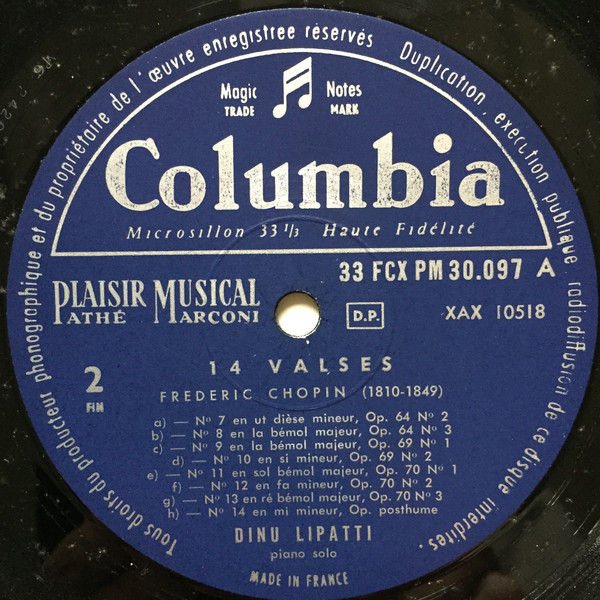
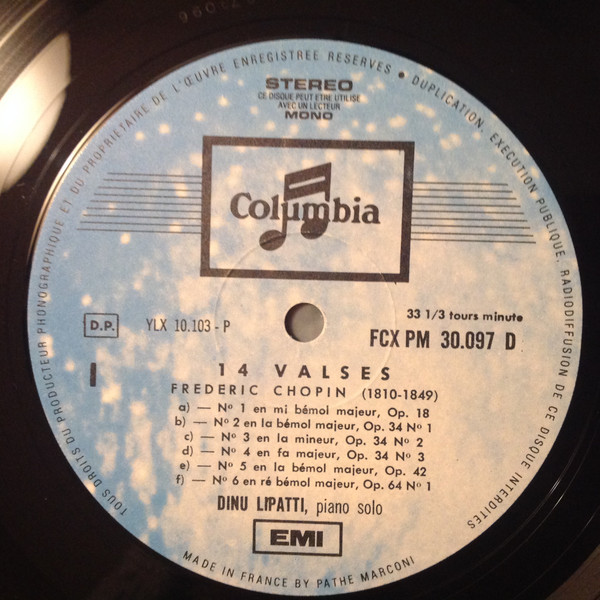
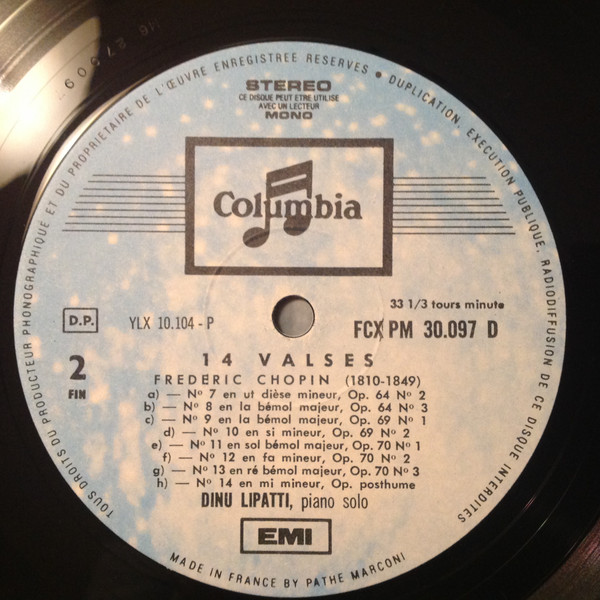
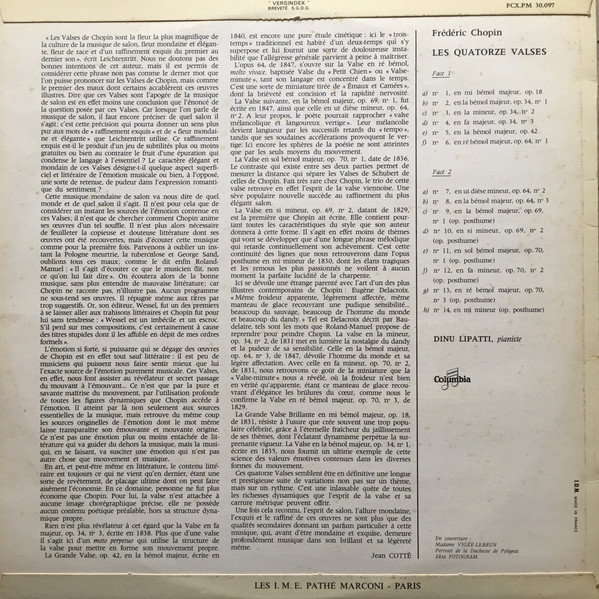
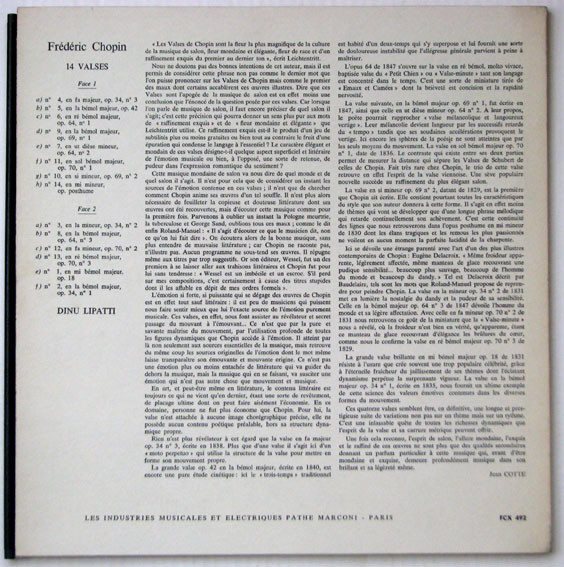
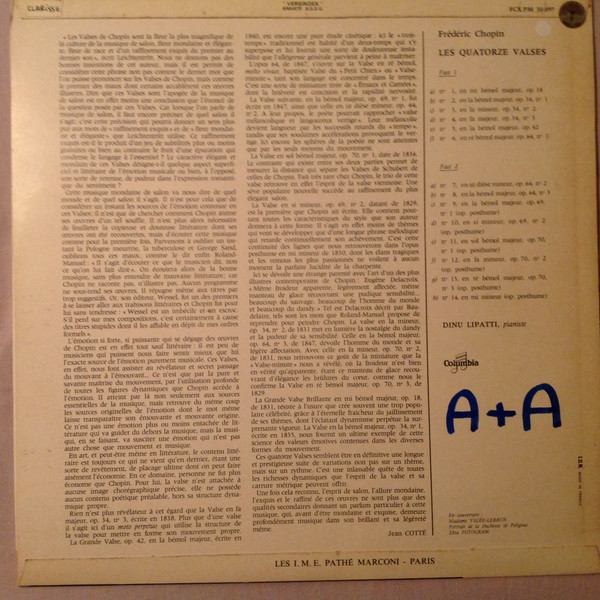
Catalog Numbers
- FCX PM 30 097
- FCX 492
- FCX.PM 30.097
Labels
- Columbia, EMI, Pathé Marconi EMI
- Columbia
Listen online
- online luisteren
- ascolta in linea
- online anhören
- ouvir online
- kuunnella verkossa
- lytte på nettet
- lyssna på nätet
- escuchar en línea
- écouter en ligne
Formats
- Vinyl
- LP
- Album
- Mono
- Reissue
Companies
| Role | Company |
|---|---|
| Record Company | Les Industries Musicales Et Electriques Pathé Marconi |
| Pressed By | Pathé Marconi, Chatou |
| Printed By | I.D.N. |
Credits
| Role | Credit |
|---|---|
| Composed By | Frédéric Chopin |
| Liner Notes | Jean Cotté |
| Piano | Dinu Lipatti |
| Engineer | Anthony Griffith |
| Illustration | Elisabeth Vigée-Lebrun (tracks: Madame Vigée-Lebrun) |
| Photography | Ekta Fotogram |
| Producer | Walter Legge |
Notes
- Blue label, drawer cover.
- Recording date & location: 07/1950, Studio 3, Radio Genève, Switzerland
- Gravure universelle
Barcodes
- Matrix / Runout (Side A Label): XAX 10517
- Matrix / Runout (Side B Label): XAX 10518
- Matrix / Runout (Side A Runout): XAX 10517 21B
- Matrix / Runout (Side B Runout): XAX 10518 21C
- Rights Society: D.P.
- Matrix / Runout: M6 230323 XAX 108 22 D
- Matrix / Runout: M6 239754 XAX 109 22 F
- Matrix / Runout (Stamped runout A): M6 279096 YLX 10103 P 21
- Matrix / Runout (Stamped runout B): M6 279097 YLX 10104 P 21
- Rights Society: D P.
About Chopin, Dinu Lipatti

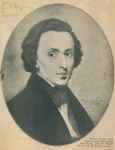



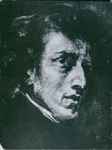
Born: 1810-03-01 (Duchy of Warsaw) at present Żelazowa Wola, Poland.
Died: 1849-10-17 (Paris, France).
Fryderyk Franciszek Chopin (1 March 1810 17 October 1849) was a Polish composer and virtuoso pianist of the Romantic era who wrote primarily for solo piano. He has maintained worldwide renown as a leading musician of his era, one whose "poetic genius was based on a professional technique that was without equal in his generation."
Chopin was born in the Duchy of Warsaw in a small town called Żelazowa Wola (eng. Steel Will), within months of his birth the Chopin family moved to Warsaw the capital of the Duchy, where Fryderyk grew up and learned to play; in 1815 the Duchy became the Kingdom of Poland. A child prodigy, he completed his musical education and composed his earlier works in Warsaw before leaving Poland at the age of 20, less than a month before the outbreak of the November 1830 Uprising. At the age of 21, he settled in Paris. Thereafterin the last 18 years of his lifehe gave only 30 public performances, preferring the more intimate atmosphere of the salon. He supported himself by selling his compositions and by giving piano lessons, for which he was in high demand. Chopin formed a friendship with Franz Liszt and was admired by many of his other musical contemporaries (including Robert Schumann). In 1835, when Chopin obtained French citizenship he became . After a failed engagement to Maria Wodzińska from 1836 to 1837, he maintained an often troubled relationship with the French writer Amantine Dupin (known by her pen name, George Sand). A brief and unhappy visit to Majorca with Sand in 183839 would prove one of his most productive periods of composition. In his final years, he was supported financially by his admirer Jane Stirling, who also arranged for him to visit Scotland in 1848. For most of his life, Chopin was in poor health. He died in Paris in 1849 at the age of 39, probably of pericarditis aggravated by tuberculosis.
All of Chopin's compositions include the piano. Most are for solo piano, though he also wrote two piano concertos, a few chamber pieces, and some 19 songs set to Polish lyrics. His piano writing was technically demanding and expanded the limits of the instrument: his own performances were noted for their nuance and sensitivity. Chopin invented the concept of the instrumental ballade. His major piano works also include mazurkas, waltzes, nocturnes, polonaises, études, impromptus, scherzos, preludes and sonatas, some published only posthumously. Among the influences on his style of composition were Polish folk music, the classical tradition of J.S. Bach, Mozart, and Schubert, and the atmosphere of the Paris salons of which he was a frequent guest. His innovations in style, harmony, and musical form, and his association of music with nationalism, were influential throughout and after the late Romantic period.
Chopin's music, his status as one of music's earliest superstars, his (indirect) association with political insurrection, his high-profile love-life, and his early death have made him a leading symbol of the Romantic era. His works remain popular, and he has been the subject of numerous films and biographies of varying historical fidelity.
Real Name
- Fryderyk Franciszek Chopin
Name Vars
- Cgoopin
- Chopin
- Chopin = ·çÑó
- Chopin F.
- Chopin Frederic
- Chopin Frederic F.
- Chopin Frédéric
- Chopin, F.
- Chopin, Fryderyk
- Chopin, Frédéric
- Chopina
- Chopìn
- Chopín
- Copin
- E. Šopenas
- F Chopin
- F F Chopin
- F, Chopin
- F. Chopin
- F. Chopen
- F. Chopin
- F. Chopin,
- F. Choppin
- F. Chopín
- F. F. Chopin
- F. Schopin
- F. Shopen
- F. Shopin
- F. Sopen
- F. Šopen
- F. Šopenas
- F. ·çÑó
- F.Chopan
- F.Chopin
- F.F. Chopin
- F.F.Chopin
- F.·çÑó
- FChopin
- FR. Chopin
- Federic Chopin
- Federico Chopin
- Fr. Chopin
- Fr. Copin
- Fr. chopin
- Fr. Šopenas
- Fr.Chopin
- Francois Frederic Chopin
- Franz Chopin
- François Frédéric Chopin
- François-Frédéric Chopin
- Frayderyk Chopin
- Freddy Chopin
- Frederic Chopin
- Frederic Choppin
- Frederic F. Chopin
- Frederic Francois Chopin
- Frederic François Chopin
- Frederich Chopin
- Frederich Chopin (R.I.P.)
- Frederick Chopin
- Frederick Chópin
- Frederico Chopin
- Frederik Chopin
- Frederik Šopen
- Frederin Chopin
- Frederique Chopin
- Frederyk Chopin
- Frederyk Franciszek Chopin
- Fredic Chopin
- Fredric Chopin
- Fredryk Chopin
- Fredédéric Chopin
- Fredéric Chopin
- Freyderyk Chopin
- Frideryk Chopin
- Friederic Chopin
- Friederyk Chopin
- Friedric Chopin
- Friedrich Chopin
- FryDeryk Chopin
- Fryderic Chopin
- Fryderick Choopin
- Fryderick Chopin
- Fryderik Chopin
- Fryderika Chopina
- Fryderyc Chopin
- Fryderyck Chopin
- Fryderyk CHopin
- Fryderyk Chopin
- Fryderyk F. Chopin
- Fryderyk F.Chopin
- Fryderyk Franciszek Chopin
- Fryderyk chopin
- Fryderyka Chopina
- Frydéric Chopin
- Frydérik Chopin
- Frydéryc Chopin
- Frydéryk Chopin
- Fryederyk Chopin
- Frèdèric Chopin
- Fréderic Chopin
- Frédèric Chopin
- Frédéeric Chopin
- Frédéric
- Frédéric Chopin
- Frédéric F. Chopin
- Frédéric Francais Chopin
- Frédéric Franciszek Chopin
- Frédéric Francois Chopin
- Frédéric François Chopin
- Frédéric Frànçois Chopin
- Frédéric-François Chopin
- Frédérich Chopin
- Frédérick Chopin
- Frédéryk Chopin
- Inspired by prelude In C Minor - F. Chopin
- Nipohc
- Plays Chopin
- Shopin
- Wagner
- chopin
- Šopen
- Σοπέν
- Ф. Шопен
- Ф. Шопен (1810-1849)
- Ф.Шопен
- Фредерик Шопен
- Фредерих Шопен
- Фредерік Шопен
- Фридерик Шопен
- Шопен
- Шопен Ф.
- Шопен Фредерик
- Шопенъ
- פרדריק שופן
- שופן
- شوپن
- ·çÑó
- ÕìÇêïû·çÑó
- խ¦
- Ǽ̽
Geert Dehoux, pianist.
Belgium.